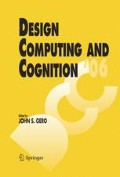Abstract
This research experiments with representations of function using analogical matching, trying to determine the benefits of using environment-centric (EC) vs. device-centric (DC) representations. We use the Structure Mapping Engine for matching, and seek to show the effect on quality and quantity of analogical matches when the representation is varied.
Access this chapter
Tax calculation will be finalised at checkout
Purchases are for personal use only
Preview
Unable to display preview. Download preview PDF.
References
Balazs, ME: 1999, Design Simplification by Analogical Reasoning. Ph.D. thesis, Worcester Polytechnic Institute, Computer Science Department, Worcester, MA, USA.
Besemer, SP and Treffinger, DJ: 1999, Analysis of creative products: Review and synthesis, in GJ Puccio and MC Murdock (eds) Creativity Assessment: Readings and Resources, Creative Education Foundation Press, Buffalo, NY. pp. 59–76.
Brain, M: 2005a, How Digital Clocks Work, http://home.howstuffworks.com/digitalclock. htm
Brain, M: 2005b, How Pendulum Clocks Work, http://home.howstuffworks.com/clock.htm
Boden, MA: 1994, What is creativity?, in MA Boden (ed), Dimensions of Creativity, MIT Press, Cambridge, MA, pp. 75–117.
Brown, DC: 1992, Design, Encyclopedia of Artificial Intelligence, John Wiley, 2nd ed, pp. 331–339.
Brown, DC and Blessing, L: 2005, The relationship between function and affordance, Proc. ASME Design Theory and Methodology Conference, DETC2005–85017.
Chandrasekaran, B and Josephson, JR: 2000, Function in device representation, Engineering with Computers 16: 162–177.
Falkenhainer, B: 2005, Structure Mapping Engine Implementation, http://www- 2.cs.cmu.edu/afs/cs/project/ai-repository/ai/areas/reasoning/analogy/sme/0.html
Falkenhainer, B, Forbus, K and Gentner, D: 1989, The structure-mapping engine: Algorithm and examples, Artificial Intelligence 20(41): 1–63.
Gentner, D, Holyoak, K and Kokinov, B (eds): 2001, The Analogical Mind: Perspectives from Cognitive Science, MIT Press, Cambridge, MA.
Goel, A: 1997, Design, analogy, and creativity, IEEE Expert 12(3): 62–70.
Hart, A: 1986, Knowledge Acquisition for Expert Systems, McGraw-Hill, New York.
Kitamura, Y, Kashiwase, M, Fuse, M and Mizoguchi R: 2004, Deployment of an ontological framework of functional design knowledge, Journal of Advanced Engineering Informatics 18(2): 115–127.
Pahl, G and Beitz, W: 2003, Engineering Design: A Systematic Approach, Springer, 2nd ed.
Prabhakar, S and Goel, A: 1996, Functional modeling of interactions between devices and their external environments for adaptive design, Proc. Modeling and Reasoning about Function workshop, AAAI-96 Conference, Portland, Oregon, pp. 95–106.
Rosenman, MA and Gero, JS: 1998, Purpose and function in design: From the socio-cultural to the techno-physical, Design Studies 19(2): 161–186.
Shaw, LG and Gaines, BR: 2005, Rep IV 1.10. http://repgrid.com, Cobble Hill, BC, Canada
Stone, RB and Chakrabarti, A (eds): 2005, Engineering applications of representations of function, AIEDAM 19(2&3): 359–370.
Stone, RB and Wood, KL: 1999, Development of a functional basis for design, Proc. ASME Design Theory and Methodology Conference, DETC99/DTM-8765.
Umeda, Y and Tomiyama, T: 1997, Functional reasoning in design, IEEE Expert 12(2): 42–48.
Author information
Authors and Affiliations
Editor information
Editors and Affiliations
Rights and permissions
Copyright information
© 2006 Springer
About this paper
Cite this paper
MILETTE, G.P., BROWN, D.C. (2006). ANALOGICAL MATCHING USING DEVICE-CENTRIC AND ENVIRONMENT-CENTRIC REPRESENTATIONS OF FUNCTION. In: GERO, J.S. (eds) Design Computing and Cognition ’06. Springer, Dordrecht. https://doi.org/10.1007/978-1-4020-5131-9_10
Download citation
DOI: https://doi.org/10.1007/978-1-4020-5131-9_10
Publisher Name: Springer, Dordrecht
Print ISBN: 978-1-4020-5130-2
Online ISBN: 978-1-4020-5131-9
eBook Packages: EngineeringEngineering (R0)

